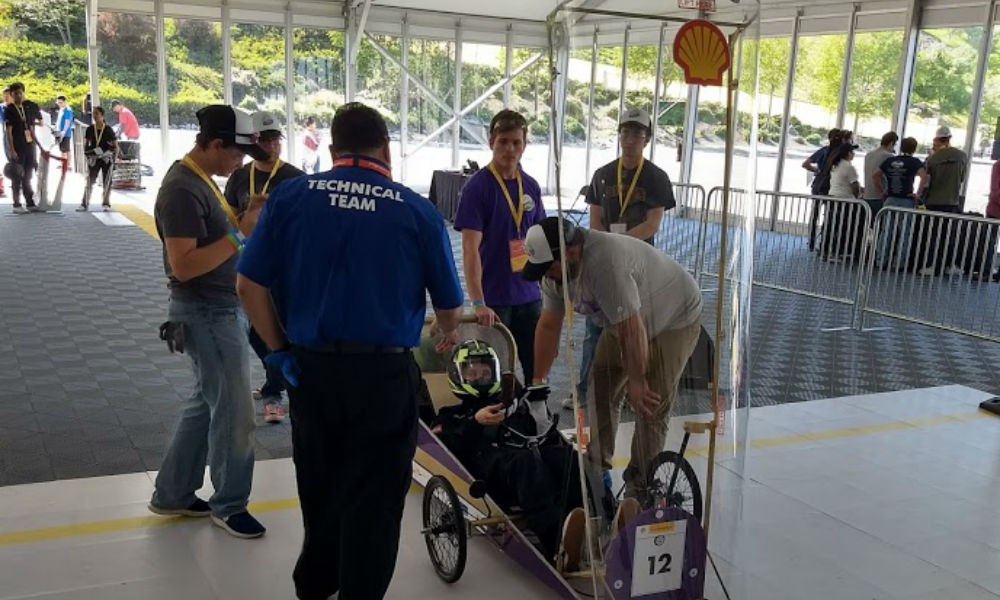Engineering students successful at Shell Eco-Marathon
Engineering
SUMMARY: A team of JMU engineering students, designed and built a one-person, fuel-efficient vehicle, which they used to compete in the 2018 Shell Eco-Marathon Americas, an international collegiate contest at the Sonoma Raceway in California. Their vehicle passed the twelve-point technical inspection, completed three runs around the track-the best of which clocked in at 184 mpg-and earned the off-track award for safety.
By Caleb Ayers
In the spring of 2015, three engineering sophomore students, Jack Boone (’18), Daniel Rauch (’18), and Joe Grabowski (’18), who were interested in automotive engineering, pursued the option of developing their own two-year engineering capstone experience to focus their engineering degrees in different areas of automotive engineering. Under the direction of engineering professors Robert Nagel and Rob Prins, the team designed their project around the Shell Eco-Marathon Americas, a “supermileage” competition where the primary goal is to develop a fuel-efficient vehicle within competition specifications.
In the fall of 2016, nine more junior engineering students joined the team. Although the students worked to develop the same vehicle, the group divided into two primary teams—chassis and propulsion—which were led by Rauch and Grabowski, respectively. While Boone worked with the chassis team, specifically in the fabrication of the vehicle, he served as the overall project manager, handling the logistics, fundraising, and communications with Shell.
Being accepted to participate in the Shell Eco-Marathon competition is not a given. In the fall of 2017, the team was informed that they were number 20 on a waitlist of 40 teams. But that didn’t stop them. In spite of being waitlisted, the team continued to make progress on their vehicle, developing major components and focusing on integration and assembly during the spring semester.
In early March, Boone received an email. The team was invited to the competition. They knew it was time to switch gears from leaving an upcoming junior team with a good platform for future development to having a competition-ready vehicle for this year. “We just decided to put our best foot forward,” said Boone.
The few weeks before the contest were a blur. The team spent hours building, tweaking, and preparing their vehicle, which they nicknamed Duke Dog. Since they did not have an official space to test drive the vehicle, the team worked through the night conducting several test runs in empty parking lots from 10 pm to 3 am. “I had a level of optimism where I felt confident that we would pass tech inspection,” said Boone.
After several weeks of focused testing, they disassembled the car, packaged it in a crate built by the team, and shipped it to Sonoma, California. Upon arrival in Sonoma, the team unpacked and reassembled their vehicle.
The Eco-Marathon, a four-day event, took place April 19th through 22nd. The event included a 12-point technical inspection along with 7-lap runs (6.5 miles) around the raceway to test gas mileage. Going into the project, the team’s goals were to build an operational vehicle, get accepted to participate in the Eco-Marathon, pass the technical inspection, and make one lap around the track. Prins and Nagel believed that completing goals one and two would be a major success for a first-year team, but the team surpassed both the advisors’ expectations and their own goals.
During their first technical inspection, the vehicle passed six of the twelve stations, so the team spent the rest of the day and the next morning trying to fix what failed. When they underwent another technical inspection, they passed all twelve of the stations. “The way they naturally assumed responsibility for the different tasks that needed to be addressed demonstrated their team mentality,” said Prins.
While their first run attempt was stopped short when the engine stalled out after 100 yards, the next three were very successful, finishing with three fuel economy results of 165 mpg, 157 mpg, and 184 mpg. In addition to their three fuel economy results, the team won the off-track award for safety, which included a trophy and a cash prize.
“Their perseverance, motivation, and drive is what allowed them to have a vehicle this past April in Sonoma and to compete in this competition,” said Nagel. “Their attention to detail is what allowed them to earn the safety award. I am very impressed by their accomplishments in two years.”
The project’s original twelve members graduated in May, but the students who joined in the fall of 2017—two of whom went to California with the team—will continue the project. The new team will have the option of making adjustments or building an entirely new car, but either way, the students will look to build on the success at the Eco-Marathon.
Through the project, Boone not only grew as an engineer, but as a businessman and project manager. “It opened my eyes that you can do so much more than what you might label yourself as,” he said. “It was the best closure I think I could have got for my time here at JMU,” he added.
